Barnes Foundation
|
The Barnes Foundation building on Franklin Parkway in Philadelphia | |
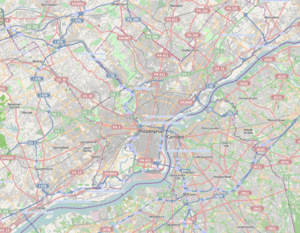 Location of the Barnes Foundation in Philadelphia, PA | |
| Established | 1922 |
|---|---|
| Location |
2025 Benjamin Franklin Parkway Philadelphia, Pennsylvania, United States |
| Coordinates | 39°57′38″N 75°10′22″W / 39.9605°N 75.1727°W |
| Type | Art Museum, Horticulture |
| Key holdings | Toward Mont Sainte-Victoire (Cézanne), Portrait of the Postman Joseph Roulin, |
| Collections | Impressionism, Post-Impressionism, Early Modern |
| Visitors | 325,000 (2013) [1] |
| Director | Thomas Collins[2] |
| Website | barnesfoundation.org |
The Barnes Foundation is an American educational art and horticultural institution with locations in Lower Merion, Pennsylvania, a suburb of Philadelphia; and Logan Square, Philadelphia. It was founded in 1922 by Albert C. Barnes, a chemist who collected art after making a fortune by co-developing an early anti-gonorrhea drug marketed as Argyrol and selling his company in 1928, just before the stock market crash of 1929.[3]
Today, the foundation owns more than 4,000 objects, including over 900 paintings, estimated to be worth about $25 billion.[4] These are primarily works by Impressionist and Modernist masters, but the collection includes many other paintings by leading European and American artists, as well as ancient works from other cultures.[5]
In the 1990s, the foundation's declining finances led its leaders to various controversial moves, including sending artworks on world tours and proposing to move the collection to Philadelphia. A 2009 documentary, The Art of the Steal, argued that the foundation had been taken over by other non-profit institutions.[6] After numerous court challenges, the new Barnes building opened on Benjamin Franklin Parkway on May 19, 2012.[7]
The foundation's current president and executive director, Thomas “Thom” Collins, was appointed on January 7, 2015.
History
Barnes era
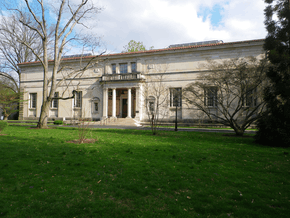
From 1912, Barnes, who derived his fortune from his development of the antiseptic drug Argyrol and a business to sell it, began to study and collect art. He was assisted at first by the painter William Glackens, a schoolmate and friend from Central High School in Philadelphia. In 1912 in Paris, Barnes visited the home of Gertrude and Leo Stein, where he became familiar with the work of such Modernist artists as Henri Matisse and Pablo Picasso. Commissioned by Barnes, Glackens selected the first 20 works he purchased from modern painters in Paris. In the 1920s, Barnes became acquainted with the work of Amedeo Modigliani and Giorgio de Chirico, thanks to the dealer Paul Guillaume.
In 1922, Barnes began to transform his collection into a cultural institution.[8] He chartered the Barnes Foundation as an educational institution in the Commonwealth of Pennsylvania. He selected the location on land in Merion that he bought from the American Civil War veteran and horticulturist Captain Joseph Lapsley Wilson, who had established an arboretum there around 1880. He commissioned architect Paul Cret to design a complex of buildings.[9] Soon afterward, a taxation dispute was filed in the Pennsylvania Supreme Court.[10]

The main building features several unusual cubist bas-reliefs, commissioned by Barnes from the sculptor Jacques Lipchitz. Barnes built his home next to the gallery, and it now serves as the administration building of the foundation. His wife, Laura, developed the Arboretum of the Barnes Foundation and its horticultural education program.
Philosophy
Barnes's conception of his foundation as a school rather than a typical museum was shaped through his collaboration with the philosopher John Dewey, who helped draw up its mandate.[11][12][13] To help with the early educational programs, Barnes hired Thomas Munro (1897–1974), one of Dewey's students at Columbia University; and Lawrence Buermeyer (1889–1970), who held a philosophy Ph.D from Princeton. Buermeyer and Munro each served as Associate Director of Education for several years, while Dewey served in the largely honorary position of Director of Education.[14][15]
Another collaborator was Violette de Mazia, who arrived as a student from Paris, became a close associate of Barnes, worked as a teacher of art education, and ultimately became head of the art education program. She accompanied him on buying trips from the 1920s through the 1940s.[16] She continued to express his philosophy after his death. The Violette de Mazia Foundation, established after her death, and the Barnes Foundation came to agreement in 2011 to continue to allow the de Mazia Foundation students access to the collection for art education after its move to the new building.[17][18]
Barnes created detailed terms of operation in an indenture of trust to be honored in perpetuity after his death. These included limiting public admission to two days a week, so the school could use the art collection primarily for student study, and prohibiting the loan of works in the collection, colored reproductions of its works, touring the collection, and presenting touring exhibitions of other art. Matisse is said to have hailed the school as the only sane place in America to view art.[19]
In 1941 and 1942, Bertrand Russell (1872–1970) gave a series of lectures on the history of philosophy at the gallery; these would later become his landmark A History of Western Philosophy.[20]
Barnes died in 1951.
Post-Barnes era
After a decade of legal challenges, the public was allowed regular access to the collection in 1961. Public access was expanded to two and a half days a week, with a limit of 500 visitors per week; reservations were required by telephone at least two weeks in advance.[21] Harold J. Weigand, an editor of The Philadelphia Inquirer, with the consent of, but not directly on behalf of, the Pennsylvania Attorney General, had filed an earlier suit for access but been unsuccessful.[22]
Financial crisis
In 1992, Richard H. Glanton, president of the foundation, said the museum needed extensive repairs to upgrade its mechanical systems, preserve its fabric, provide for maintenance and preservation of artworks, and improve security. The old Philadelphia firm J.S. Cornell & Son was the contractor of choice. In order to raise the money, Glanton decided to break some terms of the indenture. From 1993 to 1995, 83 of the collection's Impressionist and post-Impressionist paintings were sent on a world tour, attracting large crowds in numerous cities, including Washington, D.C.; Fort Worth, Texas; Paris; Tokyo; Toronto; and at the Philadelphia Museum of Art.[23][24] People opposed to the loans and touring of works from the collection challenged the decisions in court, but lost.[25]
The foundation tried to extend its opening hours and allow more visitors, but was rebuffed by the governments of Merion and Montgomery County. Later, financial irregularities were discovered in the administration of the collection. Between the renovations, the irregularities, and the associated legal expenses of court challenges, the financial situation of the Barnes declined.
The revenues earned from the tour of paintings were not enough to ensure its endowment. By fall 1998, Glanton and fellow board member Niara Sudarkasa were suing each other. Lincoln University, which controlled four of the five trustee seats by Barnes's will, began an investigation into the foundation's finances. The foundation's board believed that a similar investigation was warranted for activities during Glanton's tenure as president. In 1998, the board of directors began a forensic audit conducted by Deloitte Touche, which showed the foundation had needed greater accountability and internal controls from 1992 to 1998.[26]
In 1998, Kimberly Camp was hired as the foundation's first professional CEO. During her seven-year tenure, she turned the struggling foundation around and provided necessary support to the petition to move the Barnes to Philadelphia.
Proposed move

On September 24, 2002, the foundation announced that it would petition the Montgomery County Orphans' Court (which oversees its operations) to allow the art collection to be moved to Philadelphia (which offered a site on the Benjamin Franklin Parkway) and to triple the number of trustees to 15. The foundation's indenture of trust stipulates that the paintings in the collection be kept "in exactly the places they are".[24] The foundation argued that it needed to expand the board of trustees from five (four of which were held by persons appointed by Lincoln University) to 15 to increase fundraising.
For the same reason, it needed to move the gallery from Lower Merion to a site in Center City, Philadelphia, with greater public access, including via mass transit. In its brief to the court, the foundation said that donors were reluctant to commit continuing financial resources to the Barnes unless the gallery were to become more accessible to the public.[27]
On December 15, 2004, after a two-year legal battle that included an examination of the foundation's financial situation, Judge Stanley Ott ruled that the foundation could move.[27][28] Three charitable foundations, The Pew Charitable Trusts, the Lenfest Foundation and the Annenberg Foundation, had agreed to help the Barnes raise $150 million for a new building and endowment on the condition that the move be approved.[29]
On June 13, 2005, the foundation's president, Kimberly Camp, announced her resignation, to take effect no later than January 1, 2006. Camp had been appointed in 1998 with the goal of stabilizing and restoring the foundation to its original mission. During her tenure, she began the Collection Assessment Project, the first full-scale effort to catalogue and stabilize the artworks; brought in exemplary professional staff; created the fundraising program; restored Ker-feal and the Barnes Arboretum; and worked with the board to approve policies and procedures to make the foundation viable. In 2002, Dr. Bernard C. Watson began the proposal to move the Barnes.[30]
In preparation for the move, the foundation appointed a new Director of Education, to preserve and expand the education program in the new gallery.[31] The foundation pledged to reproduce Barnes's artistic arrangement of the artworks and other furniture within the new gallery to maintain the experience as he intended.[32]
Planning the move
In August 2006, the foundation announced that it was beginning a planning analysis for the new gallery. The board selected Derek Gillman (formerly of the Pennsylvania Academy of the Fine Arts) as the new director and president.[33] In June 2011, the foundation announced that it had surpassed its $200 million fund-raising goal, of which $150 million would go toward construction of the Philadelphia building and associated costs, and $50 million to the foundation's endowment.[34]
The foundation proceeded with plans to build a new facility in the 2000 block of the Benjamin Franklin Parkway, near the Rodin Museum and the Philadelphia Museum of Art.[35] Tod Williams & Billie Tsien Architects of New York were lead architects of the building project. The building team also consisted of the Philadelphia-based firm, Ballinger, as associate architect; OLIN as landscape architect; and Fisher Marantz Stone as lighting designers. Aegis Property Group served as external project managers, with L. F. Driscoll as construction managers. Project executive Bill McDowell supervised and coordinated the project for the foundation.[36]
Construction for the new building began in fall, 2009 and the building opened in May, 2012. The new galleries were designed to replicate the scale, proportion and configuration of the original galleries in Merion. Reviews have praised the new facility, claiming the additional natural light has improved the viewing experience. The new site contains more space for the foundation's art education program and conservation department, a retail shop, and cafe.[37]
Legal challenges to the move
After Judge Ott's decision in 2004,[28][38] The Friends of the Barnes Foundation and Montgomery County filed briefs in Montgomery County Orphan's Court to reopen the hearings that allowed the move. They hoped to persuade Ott to reopen the case because of the changed circumstances in the County. On May 15, 2008, Ott published an opinion dismissing the request of both the Friends of the Barnes Foundation and the Montgomery County Commissioners to reopen the case due to lack of standing. Congressman Jim Gerlach strongly supported keeping the Barnes in Lower Merion.[39][40]
On May 20, 2009, Friends of the Barnes Foundation appeared before the Commissioners of the Delaware River Port Authority (DRPA) in Camden, New Jersey, to request that they reconsider their 2003 authorization of a grant of $500,000 toward the plan to move the foundation. They contended there was insufficient evidence of substantial economic benefit to Philadelphia, and that DRPA had not undertaken necessary economic evaluation assessing the impact at both locations. They introduced a study by economist Matityahu Marcus that challenged the claimed benefits. The DRPA said that it would consider the Friends' request but did not change its decision.[41][42] The controversy is chronicled in the 2009 documentary The Art of the Steal.[4][5]
In late February 2011, The Friends of the Barnes Foundation filed a petition to reopen the case. A new hearing, set for March 18, was postponed until August 3, 2011. The court ordered the foundation and the Attorney General's office, who argued in favor of the move, to explain why the case should not be reopened. The opposition group, Friends of the Barnes Foundation, says The Art of the Steal revealed that Ott did not have all the evidence in 2006, when he approved the art collection's move.[43] On October 6, 2011, Judge Ott ruled that the Friends of the Barnes Foundation had no legal standing and that there was no new information in the movie.[44][45]
Collection
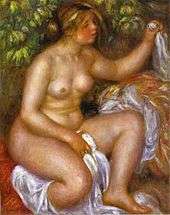
The collection includes 181 paintings by Pierre-Auguste Renoir, 69 by Paul Cézanne, 59 by Henri Matisse, 46 by Pablo Picasso, 21 by Chaim Soutine, 18 by Henri Rousseau, 16 by Amedeo Modigliani, 11 by Edgar Degas, seven by Vincent van Gogh, and six by Georges Seurat. Other European and American masters in the collection include Giorgio de Chirico, Peter Paul Rubens, Titian, Paul Gauguin, El Greco, Francisco Goya, Édouard Manet, Jean Hugo, Claude Monet, Maurice Utrillo, William Glackens, Charles Demuth, Jules Pascin and Maurice Prendergast. It also holds a variety of African artworks; ancient Egyptian, Greek, and Roman art; and American and European furniture, decorative arts and metalwork. The museum also holds several significant works by cubist sculptor Jacques Lipchitz.
The collection displays different types of items and works in "wall ensembles", which allow comparison and study of works from various time periods, geographic areas, and styles.
After Barnes met Matisse in the United States, he commissioned The Dance II, a 45-by-15-foot triptych that was placed above Palladian windows in the main gallery space.[46][47]
Notable holdings
-

Gustave Courbet, Les Bas Blancs, (Woman with White Stockings) (c. 1861)
-
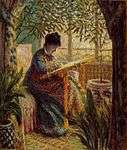
Claude Monet, Camille au métier (1875)
-

Claude Monet, Le Bateau-atelier (1876)
-

Pierre-Auguste Renoir, "Jeune garçon sur la plage d'Yport" (1883)
-

Henri Toulouse-Lautrec, A Montrouge – Rosa la Rouge (1886–87)
-

Paul Cézanne, Portrait of Madame Cézanne (1885-87)
-
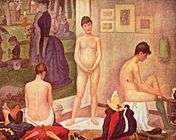
Georges Seurat, Models (Poseuses) (1886–88)
-
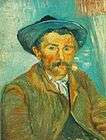
Vincent van Gogh, The Smoker (1888)
-

Vincent van Gogh, Still Life (1888)
-
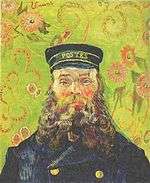
Vincent van Gogh, Portrait of the Postman Joseph Roulin (1889)
-

Vincent van Gogh, Thatched Cottages in the Sunshine (1890)
-
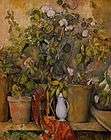
Paul Cézanne, Pots en terre cuite et fleurs (1891–92)
-

Pierre-Auguste Renoir, Noirmoutier (1892)
-

Paul Gauguin, Haere Pape (1892)
-

Paul Cézanne, The Card Players, (1890–92)
-
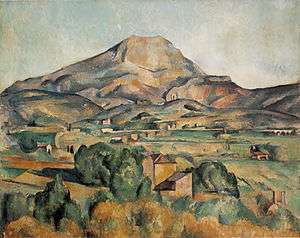
Paul Cézanne, Valley of the Arc (1892–95)
-

Paul Cézanne, Nature morte au crane (1896–98)
-
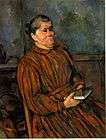
Paul Cézanne, Portrait of a Woman (c. 1898)
-
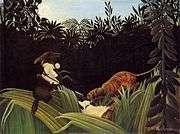
Henri Rousseau, Scout attacked by a Tiger (1904)
-
%2C_oil_on_canvas%2C_191.1_x_108.6_cm%2C_The_Barnes_Foundation%2C_Philadelphia.jpg)
Pablo Picasso, Acrobate et jeune Arlequin (Acrobat and Young Harlequin) (1905)
-
%2C_oil_on_canvas%2C_34.9_x_24.1_cm%2C_Barnes_Foundation.jpg)
Pablo Picasso, 1906, Seated Male Nude (1906)
-
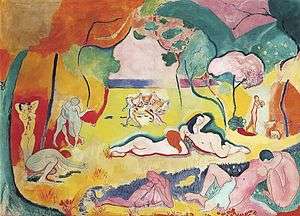
Henri Matisse, Le bonheur de vivre (1906)
-
%2C_oil_on_canvas%2C_89.5_x_116.8_cm%2C_The_Barnes_Foundation.jpg)
Henri Matisse, Nature morte bleue (Blue Still Life) (1907)
-
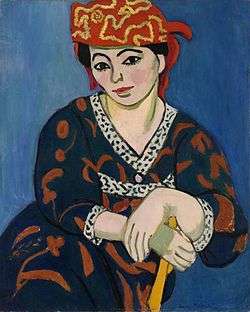
Henri Matisse, Madras Rouge (1907)
-

Henri Matisse, Le Rifain assis (1912–13)
-
%2C_oil_on_canvas%2C_100_x_81.3_cm%2C_Barnes_Foundation.jpg)
Henri Matisse, Still Life with Gourds (Nature morte aux coloquintes) (1916)
-

Pierre-Auguste Renoir, Les baigneuses (1918)
-

Amedeo Modigliani, Jeanne Hébuterne (1919)
Merion Arboretum
The original Barnes Foundation campus in Merion, Pennsylvania, is now a 12-acre arboretum open to the public for tours. The plant collection features favorite plants assembled by Mrs. Barnes for teaching purposes, and includes stewartia, aesculus, phellodendron, clethra, magnolia, viburnums, lilacs, roses, peonies, hostas, medicinal plants, and hardy ferns.[48] A herbarium and horticulture library is available to the Foundation's horticulture students and other scholars by appointment. Classes are offered in horticulture topics for the general public.
Films
- Glenn Holsten: The Barnes Collection (2012)
- Jeff Folmsbee: The Collector (2010)
- Don Argott: The Art of the Steal (2009)
- Alain Jaubert: Citizen Barnes: An American Dream (1993)
See also
References
- ↑ "Derek Gillman Steps Down as Executive Director and President of the Barnes Foundation on January 1, 2014" (Press release). The Barnes Foundation. December 3, 2013. Retrieved January 29, 2015.
- ↑ "Thomas "Thom" Collins Named Executive Director and President of the Barnes Foundation" (Press release). Barnes Foundation. January 7, 2015. Retrieved January 29, 2015.
- ↑ "The Ogre of Merion". Time magazine. June 27, 1960. Retrieved March 19, 2010.
He and a brilliant young German student, Hermann Hille, worked out the formula for Argyrol, a mild silver protein solution for which doctors had many uses—to treat gonorrhea, including gonorrheal blindness, relieve severe nasal congestion.... In 1928, with superb timing, Barnes sold out Argyrol for an estimated $4,000,000.
- 1 2 "Barnes $25 Billion Art Trove, Boardroom Fight Drive Documentary". Bloomberg. February 26, 2010. Retrieved March 12, 2010.
- 1 2 "The Art of Stealing from the Rich and Dead". Vanity Fair. March 2, 2010. Archived from the original on 4 March 2010. Retrieved March 12, 2010.
- ↑ The Daily Telegraph. November 14, 2011. Culture section.
- ↑ "Philly Home for Barnes Collection to Open May 19". September 15, 2011. Retrieved January 19, 2012.
- ↑ "Biographical Note". Albert C. Barnes Correspondence finding aid, Barnes Foundation Archives. Retrieved March 27, 2010.
- ↑ "Biographical Note". Joseph Lapsley Wilson Correspondence finding aid, Barnes Foundation Archives. Retrieved March 27, 2010.
- ↑ Barnes Foundation v. Keely, 171 A. 267 (Pa. 1934).
- ↑ Jarzombek, Mark (2000). The Psychologizing of Modernity. Cambridge University Press. p. 135. ISBN 0-521-58238-5.
- ↑ Meyers, Mary Ann (2004). Art, Education, & African-American Culture: Albert Barnes and the Science of Philanthropy. Transaction Publishers Press. ISBN 0-7658-0214-7.
- ↑ Schack, William (1960). Art and Argyrol; The Life and Career of Dr. Albert C. Barnes. Thomas Yoseloff Press.
- ↑ Journal of the Barnes Foundation, vol. 1 no.1, April 1925, p. 1.
- ↑ John Dewey, Albert C. Barnes, Laurence Buermeyer, Thomas Munro, Paul Gulliaume, Mary Mullen, & Violette De Mazia, Art and Education (Merion, PA: The Barnes Foundation Press, 1929).
- ↑ Kathy O'Loughlin, "Violette de Mazia and Dr. Albert Barnes: Partners in art", Mainline Media News, 16 November 2012, accessed 5 April 2013
- ↑ "Barnes Foundation and Violette de Mazia Foundation announce joint education agreement", Mainline Media News, 16 November 2011, accessed 5 April 2013
- ↑ "Violette de Mazia Foundation", official website, accessed 5 April 2013
- ↑ Russell, John (1999). Matisse: Father & Son. New York City: Abrams Books. p. 61.
- ↑ Russell, B: "A History of Western Philosophy", page xi. Simon & Schuster, Inc., 1972
- ↑ Commonwealth v. Barnes Found., 159 A.2d 500, 506 (Pa. 1960).
- ↑ Wiegand v. Barnes Foundation, 97 A.2d 81 (Pa. 1953).
- ↑ Kastner, Jeffrey (December 8, 1999). "Tired of Fighting: A New Director Is Trying To Turn Around the Embattled Barnes Foundation". Dalet Art. Retrieved September 13, 2007.
- 1 2 "Judge Orders Barnes Foundation To Share Audit". FoundationCenter.org. April 30, 2003. Retrieved September 12, 2007.
- ↑ In re The Barnes Found., 683 A.2d 894, 898 (Pa. Super. Ct. 1996).
- ↑ Steinberg, Don (April 12, 2003). "Barnes: Keep Audit Closed". Barnes Foundation. Archived from the original on 27 September 2007. Retrieved September 13, 2007.
- 1 2 "Montgomery Court Approves Barnes Foundation Move". PhilaCulture.org. December 15, 2004. Retrieved September 13, 2007.
- 1 2 In re Barnes Foundation, 25 Fiduc.Rep.2d 39, 69 Pa. D. & C.4th 129, 2004 WL 2903655 (Pa. Com. Pl. 2004).
- ↑ Anderson, John (2003). Art Held Hostage: The Battle over the Barnes Collection. W.W. Norton & Company. ISBN 0-393-04889-6.
- ↑ "Barnes President To Leave by January". Philly.com. Retrieved September 13, 2007.
- ↑ "The Barnes Foundation Selects Director of Education". December 23, 2008. Retrieved September 28, 2009.
- ↑ Sozanski, Edward J. (May 4, 2003). "Relocation Makes Sense, But It Would Be Wrong". Barnes Foundation. Archived from the original on 27 September 2007. Retrieved September 13, 2007.
- ↑ "Barnes Foundation Announces the Appointment of Derek Gillman as Its New Executive Director and President". Barnes Foundation. August 7, 2006. Archived from the original on 27 September 2007. Retrieved September 13, 2007.
- ↑ "Barnes passes $200M mark for new home". June 28, 2011. Retrieved January 19, 2012.
- ↑ Rybczynski, Witold (April 27, 2005). "Extreme Museum Makeover". Slate. Retrieved September 13, 2007.
- ↑ "The Barnes Foundation Announces New Building on Benjamin Franklin Parkway To Be Complete by 2011". October 16, 2008. Retrieved October 20, 2009.
- ↑ "The Barnes Foundation Announces a New Building on Benjamin Franklin Parkway To Be Complete by 2011". Barnes Foundation.
- ↑ In re Barnes Foundation, 24 Fiduc.Rep.2d 94, 2004 WL 1960204 (Pa. Com. Pl. 2004).
- ↑ "U.S. Representative Jim Gerlach's Statement Friends of the Barnes Lawsuit" (PDF). BarnesFriends.org. Retrieved September 13, 2007.
- ↑ "United Political Front Asks PA Attorney General To Reopen Barnes Case" (PDF). BarnesFriends.org. Retrieved September 13, 2007.
- ↑ "Speakers Oppose Funds For Barnes' Move to the City". The Bulletin.
- ↑ Crimmins, Peter (May 20, 2009). Peter Crimmins, "Barnes Advocates Still Trying To Stop Move", WHYY-FM. Retrieved November 10, 2011.
- ↑ AP, "Judge Sets Hearing Date in Barnes Foundation Case", reproduced at Friends of the Barnes Foundation Website
- ↑ "Effort to stop Barnes collection move quashed by court". October 6, 2011. Retrieved January 19, 2012.
- ↑ "Judge Ott's Opinion and Order Dated October 6, 2011". Friends of the Barnes Foundation. Retrieved 7 February 2014.
- ↑ New Barnes Building Opens, Why People are Upset
- ↑ Flam, Jack, Matisse: The Dance, National Gallery of Art, Washington, 1993.
- ↑ "Merion". Barnes Foundation. Retrieved 1 October 2014.
External links
| Wikimedia Commons has media related to Barnes Foundation. |
- Official website
- Friends of the Barnes Foundation
- Matityahu Marcus, "An Economist's Consideration of Delaware River Port Authority Funding for a Philadelphia Barnes Foundation Facility", Friends of the Barnes Foundation
Coordinates: 39°57′38″N 75°10′22″W / 39.9605°N 75.1727°W